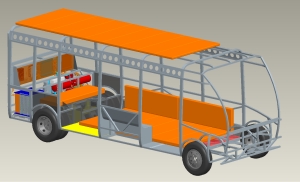Electric mobility may be economically efficient today. Battery-based electric drives can be applied efficiently in urban buses, for instance. Frequent acceleration and slow-down processes as well as a high utilization rate in short-distance traffic make their use profitable even when considering current battery costs. At the IAA International Motor Show in Frankfurt, Karlsruhe Institute of Technology (KIT) will present an e-city bus demonstrator to illustrate the concept (Hall 3.1, D13).
The key modules of the demonstrator are a drive train with a high-torque electric motor, a high-voltage network, a battery management system, and a novel modular battery system with lithium-ion cells made in Germany. At the IAA, the demonstrator developed for drive tests will present options for the design of the electric drive train of buses.
Using the demonstrator, the innovation potential of KIT’s research results can be validated and interaction of the components can be analyzed experimentally under the simulated operating conditions. “In this way, the demonstrator contributes to the further development of electric mobility,” Andreas Gutsch, coordinator of the Competence E project at KIT, explains.
The battery system consists of flat modules that can be stacked to reach the dimensions and electric characteristics desired. Various spaces in the different types of vehicles can be used for accommodating the energy storage system. The battery management system and drive control developed for the KIT demonstrator allow for driving operation taking into account the current performance limits of the system and its components.
“Energy efficiency of an electric bus can be increased by an adequate selection of components already,” says Martin Gießler, Head of the demonstrator development project. “Of course, an anticipatory operation and recuperation strategy plays an important role.” By means of recuperation, braking energy is converted into electrical energy again. The drive consists of a low-torque engine supplying a high driving torque for the vehicle. The engine is connected directly with the differential gear of the rear axle. It decreases the gear reduction to be implemented and, hence, ensures a high efficiency of torque transmission.
The e-city bus demonstrator development project was funded by the Federal Ministry of Economics and Technology.
KIT’s digital press kit relating to the IAA can be found at http://www.pkm.kit.edu/iaa2013.php
The Competence E project covers all research aspects from the battery material to the electric drive in a way that is unique in Germany. With an open technology platform for battery-electric vehicle drives and stationary energy storage systems, the systemic approach is aimed at developing industrially applicable solutions and their production methods. Thanks to integration along the chain of values added, battery systems with an energy density of 250 watt-hours / kg are to be manufactured at costs of EUR 250 per kilowatt-hour by 2018. This will be an important step towards the energy turnaround and reaching climate protection objectives: Increased storage capacity of stationary storage systems to compensate the fluctuation of renewable energy and enhanced range of electric vehicles for increased acceptance.
Find more on the Competence E project at: http://www.competence-e.kit.edu/
The Mobility Systems Center pools KIT activities relating to vehicle technology. Presently, 40 KIT institutes with about 800 employees are working on methodological and technical fundamentals for tomorrow’s vehicles. It is their objective to develop concepts, technologies, methods, and processes for future mobility considering the complex interactions of vehicle, driver, traffic, and society.
In close partnership with society, KIT develops solutions for urgent challenges – from climate change, energy transition and sustainable use of natural resources to artificial intelligence, sovereignty and an aging population. As The University in the Helmholtz Association, KIT unites scientific excellence from insight to application-driven research under one roof – and is thus in a unique position to drive this transformation. As a University of Excellence, KIT offers its more than 10,000 employees and 22,800 students outstanding opportunities to shape a sustainable and resilient future. KIT – Science for Impact.

